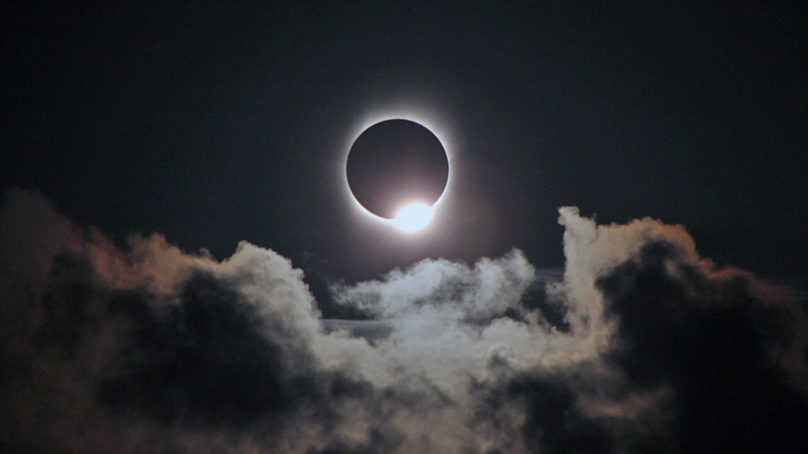
A Cosmic Coincidence: The Great American Eclipse—August 21, 2017
A Conversation with Andrew Fraknoi
It’s possible that no one has been thinking about the upcoming eclipse more than Andrew Fraknoi. The longtime professor of astronomy and former Executive Director of the Astronomical Society of the Pacific, has made a career of sharing his passion for the field, and sees the coming eclipse as an unequaled opportunity to inform, inspire, and ignite interest and excitement in astronomy—and science in general—for the general public. We spoke with Andrew at his San Francisco Bay-area office to learn more about the eclipse and what people can do to prepare for experiencing it.
Thank you for spending a bit of time with us to talk about this exciting event. Tell us, what’s so special about this particular eclipse? In what ways is it going to be different from past eclipses?
There are several things that make this eclipse unique. It’s the first eclipse to cross the continental United States since 1918—99 years ago. It’s also a rare eclipse where the path of totality goes over an entire country—a country that is actually able to respond in an organized way. (See maps of the path of totality.) Eclipses often occur over barely-populated islands or they go over a large stretch of ocean. Consequently, we expect there to be much greater interest in, and viewership of, this eclipse than a typical total eclipse usually gets. A partial eclipse will fall over all of North America. As the country wakes up to this event, there’s going to be an enormous amount of interest and many questions about it. I should also add that it’s the first US eclipse of the Internet age, which means so much more information (and perhaps misinformation) will be available to the average person.
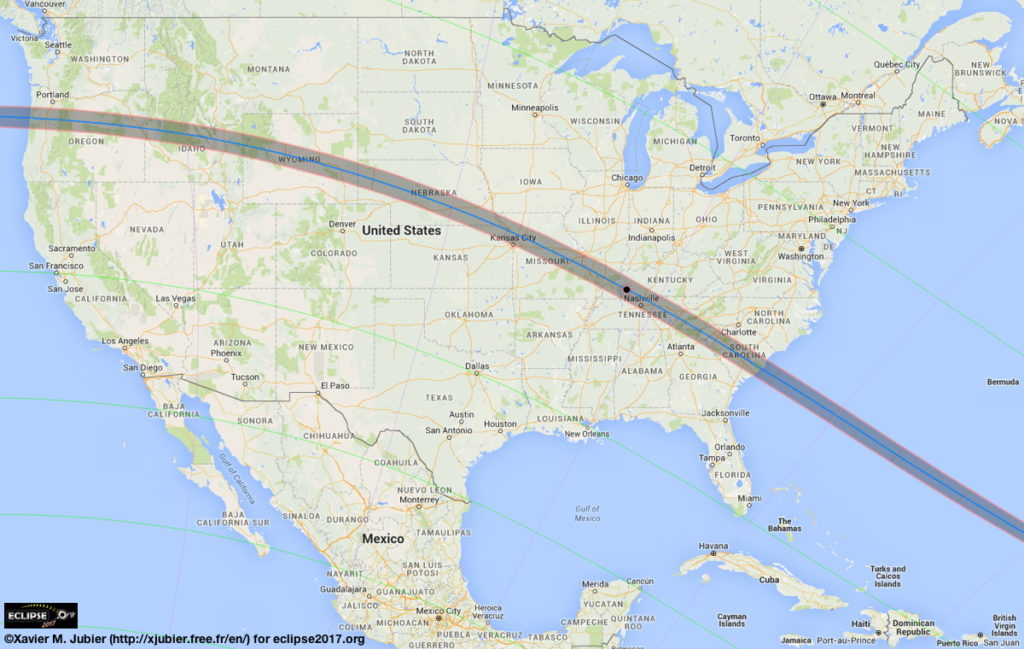
Map showing the entire path across the continental U.S. To view the total eclipse, you’ll want to be somewhere in the dark band on eclipse day.
You’ve been thinking about this event for quite some time, particularly in the context of your work in public outreach about astronomical events. More recently, though, you’ve been involved with the American Astronomical Society Eclipse Task Force. Tell us about that.
A year and a half ago, a number of us started to think about the outreach opportunities and challenges of the eclipse. The “astronomy nerds” already knew about it and were busy reserving the best campgrounds and hotel rooms in the total eclipse path, but what about the rest of the public and, particularly, people in underserved communities? The purpose of this taskforce was to help create greater awareness of the eclipse and also provide more directions for education nationwide. We’re especially concerned with safety issues, helping everyone to have proper equipment and viewing techniques, correcting misstatements in the media, and in general getting the word out about eclipse science and observing.
I understand a part of that effort was to provide free eclipse-viewing glasses for the public. How did you manage that?
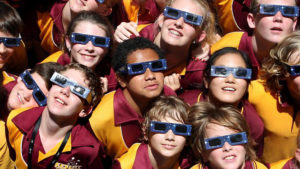
A total solar eclipse is about as bright as the full Moon — and just as safe to look at. But the Sun at any other time is dangerously bright; view it only through special-purpose “eclipse glasses” or hand-held solar viewers that meet the ISO 12312-2 international standard for such products. Homemade filters or ordinary sunglasses, even very dark ones, are not safe for looking at the uneclipsed or partially eclipsed Sun. Credit: Courtesy Mark Margolis / Rainbow Symphony
We wanted to get eclipse glasses to everyone—not just those in the path of the total eclipse but also people who will only get to see a partial eclipse. And that seemed like an impossible task. We calculated that 473 million will be able to see the partial eclipse. Even for astronomers, that’s an astronomical number! My dream was that we could get a large company like Starbucks to do the distribution for us: if every Starbucks outlet in North America made them available, they could make some money and do a wonderful public service. It turns out that they were actually approached by one of the manufacturers of the glasses but were not interested. Ultimately, though, some colleagues and I were able to get the Gordon and Betty Moore Foundation to welcome a proposal from us to distribute eclipse glasses through public libraries. They came through with 1.2 million eclipse glasses. At that time I was also working with Google on another project, so I suggested to them that if the Moore Foundation is supporting this, maybe they could, too. And they did! Google contributed another 800,000, so we have a total of two million eclipse glasses that have been distributed to 4,800 libraries all over the country. That’s not 473 million, but it’s a dent. And we’ve just learned that NASA is going to contribute another 100,000 free glasses to expand the number of libraries that can participate.
You’ve also produced a booklet about the eclipse to go along with the glasses.
Yes, and it is available free not just to the librarians, but to anyone on the Web. It’s a 24-page color booklet you can download at: http://www.starnetlibraries.org/EclipseGuide/. It provides lots of background information on the eclipse and safe viewing, plus suggestions for doing eclipse outreach events at libraries. We also have a free 8-page eclipse booklet for the public, which gives non-technical information about the eclipse in everyday language—what’s happening, exact times in various US locations, how to observe safely, etc., that you can download at http://nsta.org/solarscience.
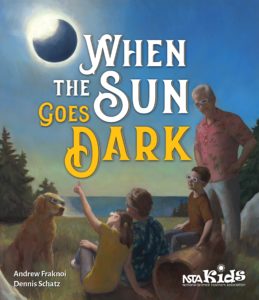
The children’s book “When the Sun Goes Dark” by Andrew Fraknoi and Dennis Schatz is published by the National Science Teachers Association, and also available on Amazon.
That’s fantastic. What are you doing for schools? August 21 is an awkward date, as many school years will not have yet started.
From an informal survey we did, about half the schools in the North American region are going to be in session, or just beginning, and half the schools will not yet be in session. So it will be complicated for young people. Many kids will be with their families and doing whatever their families are doing on that August Monday. And half will be in school but may barely know their classmates and teachers. So that presented a challenge. My writing and astronomy project partner, Dennis Schatz, and I have been thinking for more than two and a half years about how we can help young people understand and appreciate the eclipse. We’ve been doing webinars and writing articles and providing training sessions at science teacher meetings to get educators ready. We also wrote a children’s’ book called When the Sun Goes Dark (published by the National Science Teachers Association Press) that parents, librarians, and educators can use to help kids appreciate what’s happening and experience the scientific wonder of our being able to predict eclipses and understand them. You can find the book on Amazon or at the publisher’s website.
Are there any aspects about the eclipse that worry you?
I am glad that you asked. All the good things about the eclipse are also scary things about the eclipse to some degree. The eclipse will occur over the United States—it’s the only country that’s going to get the total eclipse—over a narrow path from Oregon to South Carolina. (The rest of the country is going to get an excellent partial eclipse.) But most of the path of totality is over rural areas or over small towns. The only two large towns are a corner of St. Louis and much of Nashville. So for the most part, the eclipse will happen in regions that are not highly populated. On the other hand, we’ve calculated that 47 million Americans live within a 100 mile drive of the total eclipse zone. And that means that we’re going to have the possibility of a huge last-minute migration into the eclipse zone. What worries our task force, as well as a number of government agencies, both Federal and local, is how these small towns and rural areas will cope with a sudden influx. We already know that there will be an influx of many tens of thousands of people who have planned in advance. Hotels are booked, campgrounds are booked. While there are plenty of resources available to deal with that number of people, the additional millions more will strain infrastructures in the total eclipse zone. (Think porta-potties, fresh water, food, and small rural roads crowded with cars.) In a developed country like the United States, people can make last-minute plans on a weekend to drive wherever they want. So we’re trying to get eclipse information out to everyone so they can plan ahead, bring food and drink, and so forth. It’s possible that there will be substantial gridlock on these rural roads. So be an informed and prepared traveler if you’re going to undertake this kind of last-minute trip.
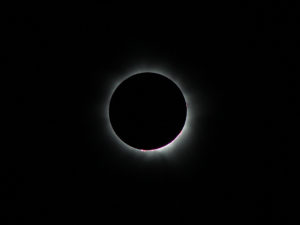
The beginning and end of totality present your best opportunities to examine the thin middle layer of the Sun’s atmosphere, called the chromosphere. It shines in the ruby-red light of hydrogen gas heated to more than 20,000° Celsius (36,000° Fahrenheit). Also visible just beyond the Moon’s silhouette are solar prominences: brilliant red arcs, loops, and jets of hot gas propelled by the explosive release of the Sun’s magnetic energy. Credit: Rick Fienberg / TravelQuest International / Wilderness Travel
For those not able to make the trip into the optimal viewing zones, contrast the experiences of observing in the path of totality versus viewing a partial eclipse.
They both have things going for them, but these are two very different experiences. There are eclipse purists who say that the total eclipse is the only thing worth seeing, but clearly that’s not a useful thing to say to the public, because the vast majority of people in America are not going to be able to see the total eclipse. It’s true that the total eclipse is an unusually beautiful thing. If you see it, you’ll remember it for the rest of your life. The Moon exactly covers the Sun and the sky goes dark in the middle of the day. It’s an eerie and awesome feeling. You see the corona—the faint atmosphere of the Sun—like a halo surrounding it, but there is also sufficient darkness that some of the brightest stars will be visible. In this case, Venus will be quite close to the Sun so everyone will be able to see Venus in the middle of the day.
Now, here’s another thing about the eclipse: sadly, it is an unusually short eclipse. Even when the eclipse is total, it won’t be for more than about two and a half minutes. But for those two and a half minutes, it’s a spectacular sight. And it’s only during those two and a half minutes that the Sun is safe to look at. Anytime a part of the Sun is showing, it’s dangerous to look at, and you need to protect your eyes, either by having special eclipse glasses or by projecting an image of the Sun instead of looking at the Sun directly. So that’s going to be the challenge for the rest of the country. But the partial eclipse, too, is beautiful in its own way. Those outside the path of totality will see a huge bite taken out of the Sun. Here in the San Francisco Bay area, 76% of the Sun will be covered at 10:15 AM when the eclipse is at its maximum. In Washington DC, at maximum eclipse, 81% of the Sun will be covered up. Even for Washington, that’s a pretty big cover-up! So in many large cities in the U.S. there will be a pretty amazing partial eclipse, which, if people have a means of observing safely, will be quite interesting. There’s a certain kind of awe to seeing so much of the Sun covered by the Moon, even if you don’t get to see the total eclipse.
Again, my interest is to help people, wherever they are, to plan ahead for SAFE eclipse viewing. If you didn’t manage to get eclipse glasses, there are other ways to observe it. For example, one fun and easy way is to simply bring a colander with you—one of those half-round metal bowls with the many holes. Those holes are exactly the right dimension for a pinhole viewer; if you hold a colander over your shoulder with your back to the Sun, the shadow that the colander makes will create dozens and dozens of pinhole images of the eclipsed Sun on the sidewalk.
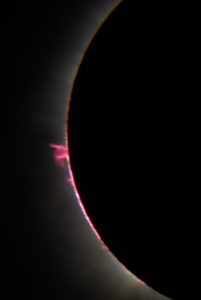
During totality, with the Moon covering all of the Sun’s brilliant face, it is perfectly OK to look at the spectacle without solar filters — indeed, if you try to observe totality through solar filters, you won’t see anything at all! Binoculars will show the chromosphere and prominences especially well. Credit: Robert B. Slobins
So the general public will learn a great deal about eclipses with this event, but what might scientists learn from it?
Given that some parts of science are now claimed to be controversial for political reasons, it’s nice to be able to show kids that the motions of the solar system are a topic where science, with a lot of understanding and a lot of preparation, has predicted to the second when the eclipse is going to happen, and we can stand in that place and experience it just as it has been predicted. That’s not news for scientists—that’s something we’ve been able to do for a long time—but it’s often news to the public.
As for scientists studying the Sun, what they’re trying to understand is the behavior of its atmosphere. The Sun has a very complicated atmosphere consisting of several layers. And this atmosphere is enormously energetic. The magnetic energy in the atmosphere of the Sun, for example, constantly launches high energy streams of particles toward the Earth and across the solar system. This “space weather” is not fully understood; it’s very complex, and not very predictable, much like weather on Earth. And because the atmosphere only becomes visible when you shut out the main light of the Sun, scientists will be studying it, watching for what happens in it over the course of the eclipse.
To this end, there are two projects run by scientists setting out to create a “mega-movie” of the eclipse, where photographers stationed from one side of the United States to the other side are going to take pictures of the event and wirelessly send them to a central location where a group of scientists and technicians will construct an ongoing movie comprised of thousands and thousands of these photographs. Each will show the atmosphere at one moment, but when stitched together they’ll make up a movie of the entire eclipse as it traverses the continent, revealing the subtle variations occurring within the Sun’s atmosphere. We know that the eclipse will last an hour and 33 minutes going from one side of the United States to the other, so we’ll have an hour-and a half movie of variations in the Sun’s outer layers that scientists will then study.
Tell me about the celestial mechanics involved in that brief hour and a half.
The eclipse is a cosmic coincidence. As seen from Earth the size of the moon in our sky and the size of the Sun in our sky happen to be the same size. From the best that we can tell, that coincidence is only true from Earth. We’ve taken photographs of the moons of Mars and the Sun from Mars, for example, and they’re not the same size. So this remarkable coincidence allows the Moon to get fully and directly in front of the Sun, making a dark shadow spot on the Earth. This time the shadow spot will be 60 to 70 miles wide. And that shadow spot will fall at any given moment on one place on the Earth.
However, the Earth turns and the moon orbits the Earth, which means that the place where the shadow spot falls on the Earth will change with time. And what’s happening this time is that the shadow spot will start in the Pacific Ocean, it will then hit a beach in Oregon, move diagonally across the United States along the curvature of the Earth, covering roughly one mile every two seconds. And so it will take about one hour and a half for that spot to travel across the United States, leaving the mainland from the Barrier Islands of South Carolina and moving into the Atlantic Ocean.
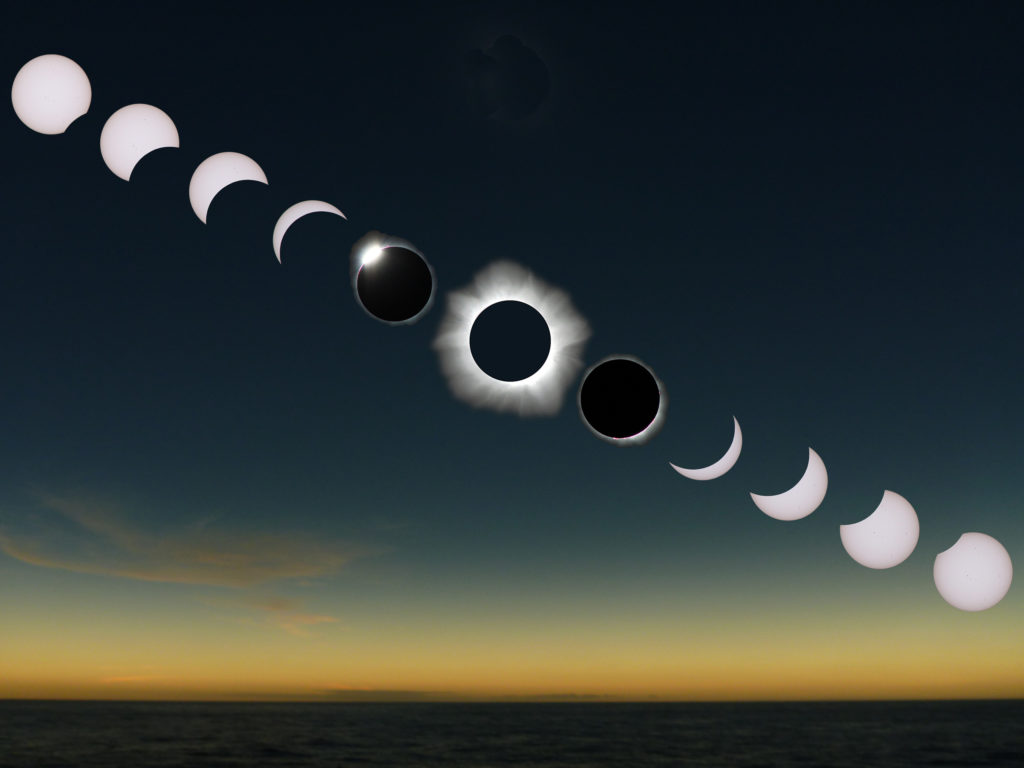
The total solar eclipse of November 14, 2012, as seen from aboard the cruise ship Paul Gauguin in the South Pacific near New Caledonia. This sequence runs from lower right to upper left. During the partial phases before and after totality, the camera lens was covered by a safe solar filter. No filter was used during totality, which is about as bright as the full Moon and just as safe to look at. The background is an unfiltered, wide-field view of the ocean and sky during totality, showing sunrise/sunset colors along the horizon. Credit: Rick Fienberg / TravelQuest International / Wilderness Travel
In helping people prepare for the eclipse, can you sum things up in a checklist?
The checklist depends a lot on where you are going to be. But let’s just say you’re the average person and therefore not in the zone of totality. Here are some things to think about. First, the eclipse is actually rather slow. Here, for example, in the San Francisco Bay area, we know that the partial eclipse will start just after 9:00 AM, it will reach its maximum at 10:15, and then the eclipse will be over; the moon will be off the Sun at just after 11:30. That’s a long time. Nobody is just going to stand there and watch the Sun do this. So people need to plan when they’re going to be observing the eclipse. On the west coast, you’ll want to be available to observe it from 10:00 to 10:30. That will take in the maximum time when the eclipse will cover most of the Sun. But first you have to be able to see the Sun. And that has two parts to it, the first of which is that no trees or buildings should be in the way. So go out the day before—on the 20th—at that hour and do a reconnaissance to see where the Sun will be clearly visible. The booklet I mentioned earlier has eclipse times for many cities.
Second, you’ll have to check weather reports. If the sky is completely cloudy on Monday, August 21, then you may not be able to see the eclipse. In San Francisco, for example, it’s often completely foggy, so you may be better off in one of the suburbs where the fog doesn’t reach.
The third thing is preparing for how you will observe the eclipse safely. Will you be able to get the eclipse glasses and also have them available for your group or your family, or will you need to bring something like a pinhole projector or a colander? By the way, there is also a method for using a hand mirror that projects the eclipse onto a wall, but that’s a skill you need to learn and practice the day before. You can learn more about all these techniques in the two booklets we prepared.
Fourth, since you’re going to be looking at the Sun, it’s probably going to be hot and so you’ll need to prepare yourself for sitting or standing in the Sun. Bring everything you’d bring to the beach—bottles of water, Sunscreen, hats, etc. Maybe bring a folding chair for each adult, have some games available for the kids while they’re waiting.
The last thing would be to read a bit in advance about what’s happening during the eclipse. Our little eight-page booklet, for example, provides some good information and all the instructions on how to observe the eclipse safely. And if there are kids in your party, perhaps you can read aloud When the Sun Goes Dark while they’re waiting for and watching the eclipse.
Thank you, Andrew, for your dedication to public outreach. This work is particularly encouraging to us, as Popular Astronomy’s mission has always been to bridge the gap between the amateur and the professional, to expand the view of science and to include more people in it. What other kinds of outreach projects are you involved with?
Well, public outreach has been the mission of my career over the last 45 years. My goal has always been to educate the public and share the excitement of astronomy with a wider range of people. One of the projects that I helped start and am still actively involved with is the American Astronomical Society Ambassadors program. It’s funded by the AAS, which is the national organization of research astronomers, and at every winter meeting of that society, we hold a two-day workshop for early-career astronomers—graduate students, post-docs, and beginning faculty—on how to do better and more outreach. The room is always full of people who want to learn how to be better at answering media questions, at doing open houses on campus, at going out into the community and doing public events. It’s been very gratifying to see over 150 serious professional astronomers take the outreach aspect of their work seriously enough to devote two days of their lives to this kind of intensive training and to become part of a community of outreach-minded people. I think more and more academics are realizing that public support of science is desperately dependent on public understanding of science and that we all need to contribute to that.
About Andrew Fraknoi
Andrew Fraknoi is an award-winning science educator who is known for his skill in interpreting astronomical discoveries and ideas in everyday language. In 2007, while he was Chair of the Astronomy Department at Foothill College, he was selected as Professor of the Year for the state of California by the Carnegie Endowment for Higher Education. For 14 years, Fraknoi served as the executive director of the Astronomical Society of the Pacific, an international scientific and educational organization founded in 1889. He was also editor of its popular-level magazine, Mercury, and started its newsletter for teachers, Universe in the Classroom. He founded and directed Project ASTRO, a program that trains and brings professional and amateur astronomers into 4th – 9th grade classrooms (still operating in a number of regional sites throughout the U.S.). After retiring as executive director, he worked as senior educator for the Society, developing educational materials and leading workshops. Asteroid 4859 has been named Asteroid Fraknoi by the International Astronomical Union to honor his work in sharing the excitement of modern astronomy with students, teachers, and the public. Learn more about him at http://foothill.edu/astronomy/fraknoi.php.
To Learn More about the Upcoming Eclipse . . .
Register for your FREE subscription to Popular Astronomy, which features an in-depth article about the eclipse by Dr. Jeffrey Bennett, as well as links to his special eclipse app.
Additional safety information about viewing the Sun is found at the American Astronomical Society eclipse web site: https://eclipse.aas.org/eye-safety/safe-viewing
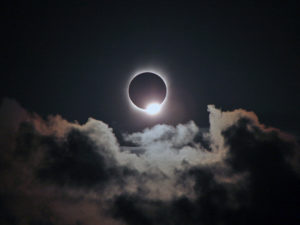 About the Featured Image
About the Featured Image
One of the most beautiful sights associated with a total solar eclipse is the “diamond ring.” It appears just before the beginning of totality, when a single bright point of sunlight—the diamond—shines through a deep valley on the Moon’s limb (edge) and the inner corona—the ring—becomes visible. As the diamond vanishes, it’s safe to remove your solar filters. A second diamond ring appears at the end of totality when a deep valley on the opposite side of the retreating Moon exposes a single bead of bright sunlight that begins to wash out the corona. Put your filters back on!
We asked the photographer, Rick Fienberg, how he captured this spectacular image. “I shot this photo,” he explained, “at the end of the July 22, 2009, total solar eclipse with a Canon EOS Rebel T3i DSLR and 18-270-mm zoom lens racked all the way out to 270 mm. I was aboard the TravelQuest International / Wilderness Travel eclipse cruise in the Cook Islands aboard the M/S Paul Gauguin, a wonderful 332-passenger liner that has been to four or five eclipses already and is booked again for July 2019 in the South Pacific (when I’ll be aboard again). We had to maneuver the ship quite a bit to keep the Sun in a hole in the clouds, and when the diamond ring appeared at the end of totality, it lit up the surrounding clouds spectacularly, which is why my photo is so nice!”
Image courtesy of Rick Fienberg / TravelQuest International / Wilderness Travel






